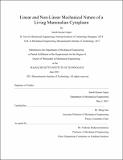Linear and Non-Linear Mechanical Nature of a Living Mammalian Cytoplasm
Author(s)
Gupta, Satish Kumar
DownloadThesis PDF (2.662Mb)
Advisor
Guo, Ming
Terms of use
Metadata
Show full item recordAbstract
Cytoplasm is a complex active material wherein numerous biochemical processes occur, which are critical for functioning of a cell. Many of the biological processes, such as cell migration, mechanotransduction, and cancer metastasis, involve mechanical processes and are critically regulated by cell mechanics. This thesis comprises of three parts with a common goal of understanding the mechanical nature of the cytoplasm.
In the first part of the thesis, we develop high-frequency passive microrheology, a high-throughput, non-invasive, and inexpensive method to measure the frequency dependent complex moduli of the cytoplasm using the fluctuations of tracer particles. We use a combination of theoretical and experimental analysis to show that although the cytoplasm operates far-from-equilibrium, it behaves as an equilibrium material at short time-scales. This allows us to extract its mechanical properties using the generalized Stokes-Einstein relationship. The results obtained agree with independent optical tweezers measurements.
In the second part of the thesis, we systematically show that cell polarity, which is known to facilitate a diverse set of cellular processes such as directional cell migration, differentiation, localized membrane growth, activation of the immune system, is a critical regulator of the anisotropic behavior of mechanics, dynamics and forces within the cytoplasm. We demonstrate that the changes in cell shape can significantly modify the cytoskeletal organization and regulate the degree of mechanical anisotropy.
We develop microscopic medium amplitude oscillatory shear (µMAOS), a novel method to measure the frequency-dependent micromechanical properties of soft materials in the asymptotically nonlinear regime using optical tweezers. We have developed a theoretical framework to extract these nonlinear mechanical properties of the material from experimental measurements and also proposed a physical interpretation of the third-order nonlinearities measured in single-tone oscillatory tests. We demonstrate the method for a well-characterized surfactant solution of wormlike micelles, and subsequently employ this novel technique to demonstrate that the cytoplasm of a living cell undergoes strain softening and shear thinning when locally subjected to weakly nonlinear oscillatory deformations.
Date issued
2021-06Department
Massachusetts Institute of Technology. Department of Mechanical EngineeringPublisher
Massachusetts Institute of Technology